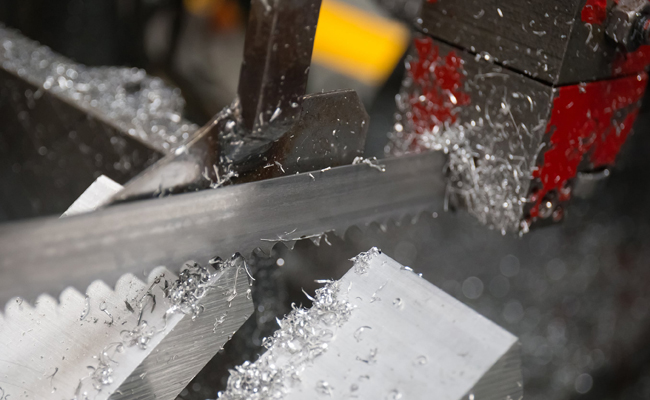CLM4370 CNC Band Saw Machine
Cutting Capacity :
When selecting a bandsaw blade, it is essential to match the blade to the workpiece material to ensure cutting efficiency and blade longevity. Below are recommendations for common materials and their corresponding bandsaw blade choices:

1. Carbon Steel
Recommended Blade: Bi-metal bandsaw blade
Characteristics: Carbon steel has moderate hardness. Bi-metal blades, which combine high-speed steel teeth with a flexible backing, are suitable for efficient cutting of carbon steel.
2. Stainless Steel
Recommended Blade: Bi-metal or carbide-tipped bandsaw blade
Characteristics: Stainless steel is hard and prone to work hardening. Bi-metal blades are suitable for general cutting, while carbide-tipped blades are ideal for high-precision or high-volume cutting.
3. Alloy Steel
Recommended Blade: Bi-metal bandsaw blade
Characteristics: Alloy steel has high hardness, and bi-metal blades provide excellent wear resistance and cutting efficiency.
4. Aluminum and Aluminum Alloys
Recommended Blade: Carbon steel or bi-metal bandsaw blade
Characteristics: Aluminum is relatively soft. Carbon steel blades are sufficient for general needs, while bi-metal blades are better for high-volume cutting.
5. Copper and Copper Alloys
Recommended Blade: Bi-metal bandsaw blade
Characteristics: Copper is soft but prone to gumming. Bi-metal blades effectively reduce gumming during cutting.
6. Titanium and Titanium Alloys
Recommended Blade: Carbide-tipped bandsaw blade
Characteristics: Titanium alloys are hard and wear-resistant. Carbide-tipped blades are suitable for efficient cutting.
7. Plastics
Recommended Blade: Carbon steel bandsaw blade
Characteristics: Plastics are soft, and carbon steel blades are sufficient for cutting.
8. Wood
Recommended Blade: Carbon steel or specialized wood-cutting bandsaw blade
Characteristics: Wood is soft, and carbon steel blades or specialized wood-cutting blades are suitable for cutting.
9. Composite Materials
Recommended Blade: Carbide-tipped bandsaw blade
Characteristics: Composite materials are hard and wear-resistant. Carbide-tipped blades are suitable for efficient cutting.
Additional Considerations When Selecting a Bandsaw Blade:
Tooth Pitch: Choose the appropriate tooth pitch based on the workpiece thickness. Use fine teeth for thin materials and coarse teeth for thick materials.
Blade Width: Select the blade width based on whether you are cutting curves or straight lines. Narrow blades are for curved cuts, while wide blades are for straight cuts.
Cutting Speed: Adjust the cutting speed according to material hardness. Use slower speeds for hard materials and faster speeds for soft materials.
Bi-metal Bandsaw Blades: Suitable for cutting most metals.
Carbide-tipped Bandsaw Blades: Ideal for high-hardness and high-wear-resistant materials.
Carbon Steel Bandsaw Blades: Suitable for soft materials or non-metal cutting.
Choosing the right bandsaw blade based on the workpiece material and cutting requirements can significantly improve cutting efficiency and blade lifespan.
Cutting Capacity :
Cutting Capacity :